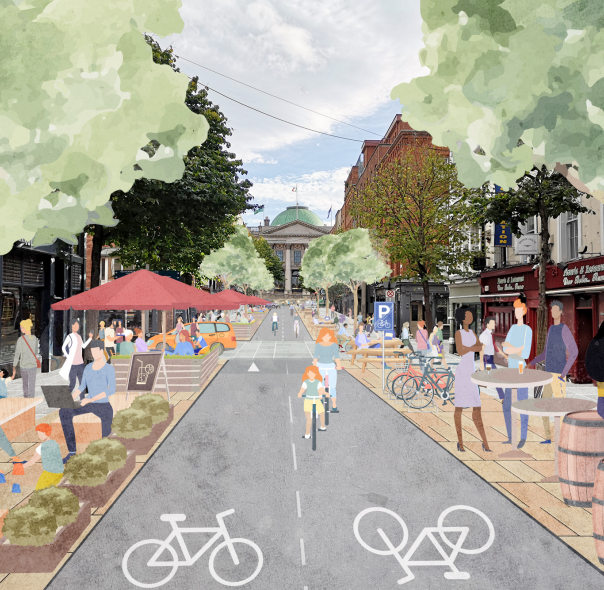Plans to alter the transport system of Dublin have been announced by Dublin City Council and the National Transit Authority.
The draft plan would see sections of the North and South Quays reallocated for public transport, new traffic arrangements introduced along Westland Row, as well as more space reallocated for pedestrians and cyclists on Pearse Street, Tara Street, Beresford Place and Gardiner Street.
The most eye-catching element of the draft plans includes implementing a 30 km/h speed limit in the city centre, a new civic plaza at Lincoln Palace, and Parliament Street becoming traffic-free.
Two new “bus gates” would be introduced on the quays close to O’Connell Bridge, one on the northside at Bachelors’ Walk preventing cars and lorries from heading east towards the Custom House and the docklands.
The other bus gate would be on Aston Quay on the southside, stopping private traffic from travelling from O’Connell Bridge in the direction of Heuston Station.
Both bus gates are due to be in place from next year.
Members of the public are being encouraged to engage with the consultation process, which will be open until December 1st.
Dublin City Council said “the overall transport vision in this plan is for a low-traffic city centre with public transport, walking and cycling being prioritised.”
They said the plan “draws lessons from the response to the pandemic whereby low traffic volumes allowed very ambitious changes to be undertaken in areas such as Capel Street, Nassau Street and along the North and South Quays.”
“The traffic management changes envisaged as part of this plan aim to significantly reduce volumes of car traffic in the city centre, opening up space for the sustainable modes, and significantly improving the public realm by allowing greening and the development of new public spaces for residents, workers and visitors to the city centre.”
Reactions to the proposals have been mixed, with Green Party Councillor Michael Pidgeon noting “even at the morning peak, there are only about 270 cars going through the north quays per hour. Assuming average occupancy, it’s about 4 or 5 buses worth of people. Traffic on the quays is a solvable problem. We should solve it!”
Independent Councillor Noeleen Reilly and Chair of the Traffic and Transport Special Policy Committee welcomed the publication of the plan, but said the concerns of businesses.
“It is great to see this plan go out to public consultation. Our city centre could deliver so much more for the people of Dublin than it is currently doing.”
“We have seen the success of some temporary closures and how it brought vitality back to those areas in the city.”
“If you go to other European cities there are large central public spaces for people to enjoy, to bring their kids in for tourists to get a real feel of the city.”
“However, having said that this plan will only work if public transport is greatly increased across the whole city – the last thing we want is to stop cars coming into the city centre and then people cannot get in at the times they need to.”
The Councillor said that the local business community “needs to be heavily involved in any decision made as they will be impacted.”
“We are trying to reduce the level of traffic and make the area safer for people to enjoy, the result cannot be that fewer people are coming in as this will have a negative effect on economic activity.”
Newstalk Breakfast presenter Jonathan Healy claimed “if you don’t have a destination in the city centre, they don’t want you passing through.”
“We have been talking about extra DARTs we have been talking about Metros, I mean look how long it took to join up the two Luas lines,” he said.”
“Buses and bus corridors and all the challenges of Bus Connects – we do not have the public transport infrastructure for people to abandon their cars in their entirety,” he asserted.
Trinity lecturer in Transportation Brian Caulfield said that a “lot of political bravery is needed” to bring about changes to Dublin’s transport system, and said that other major cities with robust transport systems have a directly-elected mayor.
Dubliners may get the chance to vote for a directly-elected mayor next summer, which would roughly coincide with when the plans are being implemented.
Professor Caulfield said it was “a great plan,” but will need “massive political leadership and bravery to get it done.”
He added “it also needs lots of consultation and dialogue as this space is for everyone.”
